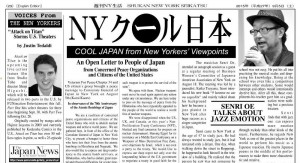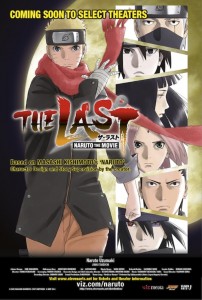Justin’s Japan: ‘Naruto’ takes Comic Con, ‘Legend of Zelda,’ L’Arc~en~Ciel
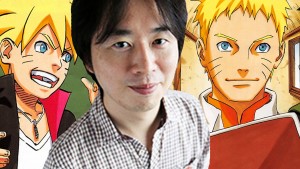
Naruto creator Masashi Kishimoto makes his first-ever appearances outside of Japan in New York Oct. 7-10. (Courtesy of ForeverWorld)
By JQ magazine editor Justin Tedaldi (CIR Kobe-shi, 2001-02) for Examiner.com. Visit his Japanese culture page here for related stories.
The Japan-centric events of the month ahead promise to be as rich and full as autumn itself—brisk and colorful, with a dash of unpredictability.
This month’s highlights include:
Oct. 8-11
Jacob K. Javits Convention Center, 655 West 34th Street
Limited tickets available
The East Coast’s biggest gathering for fans of comics, film, anime and manga, New York Comic Con returns with its biggest roster of Hollywood talent to date, including the first-ever appearance outside of Japan of Naruto creator Masashi Kishimoto, on hand for an exclusive Q&A panel (Oct. 8, 5:30 p.m.) as well as the North American theatrical debut (Oct. 10, 11:30 a.m. at Hammerstein Ballroom) of Boruto: Naruto the Movie! In addition, Kishimoto will also make live appearances at Apple Store SoHo (Oct. 7, 7:00 p.m.), Kinokuniya Book Store (Oct. 9, 8:30 p.m.) and Barnes and Noble Tribeca (Oct. 10, 3:30 p.m.). Don’t miss this chance to meet one of Japan’s most popular contemporary manga artists!
Oct. 9-Jan. 10
For a New World to Come: Experiments in Japanese Art and Photography, 1968-1979 Japan Society Gallery, 333 East 47th Street
$12 students and seniors, $10, Japan Society members. Free on Friday nights, 6:00-9:00 p.m.
In the wake of the social and political upheaval of the late 1960s, Japanese artists and photographers began crafting a new visual language for an age of uncertainty. Their embrace of camera-based experiments would alter the cultural landscape and lay the foundations for contemporary art in Japan. For a New World to Come is the first comprehensive exhibition to spotlight this radical break with the past. With some 200 works by such luminaries as Ishiuchi Miyako, Daidō Moriyama, Jirō Takamatsu, and Shōmei Tōmatsu, the exhibition charts the stunning diversity of photographic practices during this pivotal era, from conceptual series situated squarely within global artistic currents, to visually arresting meditations on time, place, and self.
Oct. 10, 12, 13, 17, 19, 21
Village East Cinema, 181-189 2nd Ave.
$15
See the next generation of Naruto on the big screen! With Naruto as the Seventh Hokage, Hidden Leaf Village is planning to host the Chunin Exams to train new shinobi. Among the entrants are Sasuke’s daughter, Sarada, who adores Naruto, Mitsuki, an exceptionally talented yet mysterious shinobi, and Boruto, Naruto’s son who shows great potential, but despises his father. Sasuke, who’s been on a mission in another dimension, appears before Naruto to warn of a strange impending danger he has sensed. An inconceivable foe lies in wait as Sasuke, the Five Kage, and Boruto charge into another dimension!Presented in Japanese with English subtitles.
For the complete story, click here.
Nippon in New York: ‘Attack on Titan,’ Taylor Anderson Memorial, Luckyrice Fest

The live-action film debut of Attack on Titan premieres at Village East Cinema Sept. 30. (Courtesy of FUNimation)
By JQ magazine editor Justin Tedaldi (CIR Kobe-shi, 2001-02) for Examiner.com. Visit his Japanese culture page here for related stories.
As the summer winds fade into fall colors, the weeks ahead are shaping up with these exciting events, ready to be enjoyed after Labor Day.
This month’s highlights include:
Tuesday, Sept. 8, 6:30 p.m.
Japanese Design Today: Unique, Evolving, Borderless
UL105, University Center, The New School, 63 Fifth Ave.
Free (click here to register)
Japanese design has been proven capable of transcending language barriers and fostering communication and understanding between cultures, enthusiastically embracing elements of other cultures while developing and retaining its own unique sense of design aesthetic, which today is recognized and appreciated throughout the world. But as Japanese society has transformed socially, geopolitically, and economically, so has Japanese design transformed to accommodate these changes which has given way to a new era. Hiroshi Kashiwagi, professor at Musashino Art University, and architect/ furniture designer Yoshifumi Nakamura will each discuss the evolution, distinguishing characteristics, and current state of Japanese design today. A Q&A session will follow the presentations.
Friday, Sept. 11, 7:00 p.m.
The Concert Hall — New York Society for Ethical Culture, 2 West 64th Street
$20
Celebrating its eighth annual concert, this year Circle Wind will give tribute to Taylor Anderson, an American victim of the the Great East Japan Earthquake/Tsunami on March 11, 2011. Anderson was dispatched to Ishinomaki under The Japan Exchange and Teaching (JET) Program in 2008 and was teaching English to schoolchildren there. The newly formed “Never Give Up Taylor’s Choir” from the Ishinomaki/Higashi-Matsushima area will perform an original piece symbolizing their appreciation for the American people’s support to recover from the devastation in 2011. Maestro Gregory Singer and his Manhattan Symphonie Orchestra also returns to perform some tribute songs for Taylor together with koto soloist Masayo Ishigure and other prominent artists. Hosted by New York’s choral harmony group Tomo.
Saturday, Sept. 12
Double feature: Live Your Dream and Dream Beyond 400 Years
Nippon Club of New York, Rose Room, 145 West 57th Street
$10 per film (at 5:00 p.m. and 6:45 p.m.)
Live Your Dream is a story about the courage and sacrifice of Taylor Anderson and for all the young people who travel the world trying to make a difference. Taylor was an extraordinary American who on the JET Program dedicated herself to teaching Japanese children, living her dream right up to the disaster of March 11, 2011. In the New York premiere of Dream Beyond 400 Years, local choir Tomo took a journey to Coria Del Rio in Spain, representing a journey going beyond 400 years. In this town, they met “Japón-san,” the descendants of Japanese travelers to Spain 400 years ago. The members of Tomo and Japón-san form a lifelong friendship in this touching real-life story. An after-screening reception featuring Circle Wind Concert participants and members of Taylor Anderson’s family will be held at 7:30 p.m. ($40).
For the complete story, click here.
Justin’s Japan: ‘Attack on Titan’ Storms U.S. Theaters
By JQ magazine editor Justin Tedaldi (CIR Kobe-shi, 2001-02) for Shukan NY Seikatsu. Visit his Examiner.com Japanese culture page here for related stories.
Attack on Titan is the upcoming live-action feature film from Studio Toho and director Shinji Higuchi, which will be released in two parts in the U.S. by FUNimation Entertainment this fall. Part One hits select theaters for three days beginning Sept. 30, with Part Two following Oct. 20.
Originally created by manga artist Hajime Isayama in 2009 and currently published by Kodansha Comics in the U.S., Attack on Titan has over 50 million copies in print, as well a 25-episode anime series, also produced by FUNimation for American audiences. The series is so popular that a special Titan-themed attraction opened at Universal Studios Japan earlier this year.
The film’s official U.S. release comes swiftly after Part One’s world premiere at the Egyptian Theater in Los Angeles on July 14 and its Japanese release on Aug. 1. Written by Yusuke Watanabe, the films star Haruma Miura and Kiko Mizuhara as two young soldiers living in a deadly post-apocalyptic land where humans fight man-eating Titans for their very survival.
“FUNimation is honored to host the world premiere of Attack on Titan here in the United States with Toho,” said FUNimation president and CEO Gen Fukunaga in a press release. “Attack on Titan is truly a worldwide phenomenon and we are excited to bring the live-action movie to theaters.”
For more information, visit http://attackontitanthemovie.com.
Justin’s Japan: Nippon in New York—‘Dragon Ball Z,’ Liberty City Anime Con, Waku Waku NYC
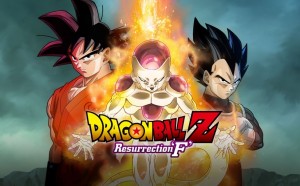
Dragon Ball Z: Resurrection ‘F’ premieres the week of Aug. 3 at three Manhattan-area locations. (FUNimation)
By JQ magazine editor Justin Tedaldi (CIR Kobe-shi, 2001-02) for Examiner.com. Visit his Japanese culture page here for related stories.
In the dog days of summer, it’s best to escape the heat in a place that’s cozy and cool. For those into Japanese cultural events, this month offers a diverse selection of film premieres and live music—all in the comfort of indoor air conditioning.
This month’s highlights include:
Aug. 4, 5, 7, 8 & 11
Dragon Ball Z: Resurrection ‘F’
AMC Empire 25, 234 West 42nd Street
Chelsea Cinemas, 260 West 23rd Street
Village East Cinema 7, 181-189 2nd Avenue
$15
Hot on the heels of last year’s summer blockbuster, Battle of Gods, Resurrection ‘F’ is the second film personally supervised byDBZ creator himself, Akira Toriyama. The new movie showcases the return of Frieza, the galaxy’s most evil overlord. After years in spiritual purgatory, Frieza has been resurrected and plans to take his revenge on the Z-Fighters of Earth. Facing off against Frieza’s powerful new form and his army of 1,000 soldiers, Goku and Vegeta must reach new levels of strength in order to protect Earth from their vengeful nemesis. English dub version.
Friday, Aug. 28, 6:00 p.m.
Always: Sunset on Third Street 3
Japan Information Center Gallery, Consulate General of Japan in New York
299 Park Avenue, 18th floor
Free (email RSVP to kanako_shirasaki[at]jfny.org; photo ID required upon entry)
A special screening of the third film in the wildly popular series! In 1964, novelist Ryunosuke Chagawa (Hidetaka Yoshioka) has married Hiromi (Koyuki), and the two now share a happy life with Junnosuke (Kenta Suga), the young boy he had taken in during the first film, who is now in high school. Hiromi is also pregnant, and the family prepares to welcome a new addition to their household. One day, Hiromi discovers a telegram that Chagawa had hidden. Who sent this telegram? What is the surprising identity of this new, rival writer? And what future awaits the people of Third Street? Presented in Japanese with English subtitles.
Aug. 28-30
Crowne Plaza White Plains, 66 Hale Avenue
$50 for weekend pass
The best three-day anime convention (just north of) New York City, the inaugural Liberty City Anime Con features over 100 events and panels, a dozen guests and entertainers, three days of cosplay, game tournaments and anime screenings, and concerts, balls and dances. Guest performers include idol singer Reni Mimura, female J-pop group Starberry, and New Jersey-based anime, video game and J-pop cover band Moshi Moshi.
For the complete story, click here.
WIT Life #290: Round Trip Heart/Our Little Sister
WIT Life is a periodic series written by professional Writer/Interpreter/Translator Stacy Smith (Kumamoto-ken CIR, 2000-03). She starts her day by watching Fujisankei’s newscast in Japanese, and here she shares some of the interesting tidbits and trends along with her own observations.
A business trip to Japan prevented me from viewing the majority of the films at this year’s Japan Cut s at Japan Society, but I was able to catch Round Trip Heart (ロマンス) during the festival’s opening week. Starring Yuko Oshima best known as a singer from the idol group AKB48, this film tells the story of an emotionally lost young woman whose job is to serve refreshments on board the train servicing the hot springs area of Hakone just outside Tokyo. It is through a chance encounter with a seemingly sleazy customer that enables her to examine her past and be able to look toward the future. This seemingly simple but touching movie made its North American premiere at Japan Cuts and was released in Japan the next week, so it was cool to be able to get a sneak peak ahead of the domestic market.
s at Japan Society, but I was able to catch Round Trip Heart (ロマンス) during the festival’s opening week. Starring Yuko Oshima best known as a singer from the idol group AKB48, this film tells the story of an emotionally lost young woman whose job is to serve refreshments on board the train servicing the hot springs area of Hakone just outside Tokyo. It is through a chance encounter with a seemingly sleazy customer that enables her to examine her past and be able to look toward the future. This seemingly simple but touching movie made its North American premiere at Japan Cuts and was released in Japan the next week, so it was cool to be able to get a sneak peak ahead of the domestic market.
Although I was sad to miss most of Japan Cuts, being in Tokyo allowed me to check out the newest work from my favorite Japanese director, Hirokazu Kore-eda, who I have written about numerous times here. It is called Our Little Sister (海街diary, literally Seaside Town Diary) and is based on the eponymous manga by Akimi Yoshida. It tells the story of Read More
to miss most of Japan Cuts, being in Tokyo allowed me to check out the newest work from my favorite Japanese director, Hirokazu Kore-eda, who I have written about numerous times here. It is called Our Little Sister (海街diary, literally Seaside Town Diary) and is based on the eponymous manga by Akimi Yoshida. It tells the story of Read More
WIT Life #289: NY Asian Film Festival
WIT Life is a periodic series written by professional Writer/Interpreter/Translator Stacy Smith (Kumamoto-ken CIR, 2000-03). She starts her day by watching Fujisankei’s newscast in Japanese, and here she shares some of the interesting tidbits and trends along with her own observations.
This year’s NY Asian Film Festival is showcasing 11 films as part of its focus on new cinema from Japan. I had the chance to catch two of them, Permanent Nobara (パーマネント野ばら) and Chasuke’s Journey (天の 茶助).
茶助).
The former flick stars the drama and film fixture Miho Kanno and the seemingly non-aging Yosuki Eguchi in a story set in a small fishing village in Shikoku (with dialogue in the regional dialect). Kanno’s character Naoko has returned to her hometown with her daughter, after divorcing her husband and leaving her life in Tokyo. Her mom runs the only town’s beauty salon, whose signature service is perms. The regulars gather there to snack and gab while getting their hair done, and this convivial and often raunchy atmosphere reminded me of the relationships between the women in Steel Magnolias.
Various aspects of Naoko’s life growing up in the village are revealed via flashback, including Read More
Justin’s Japan: Nippon in New York—JAPAN CUTS, Kishi Bashi, ‘Kafka on the Shore,’ Keiko Matsui

HIBI ROCK: Puke Afro and the Pop Star kicks off this year’s JAPAN CUTS film festival at Japan Society July 9. (© 2014 HIBI ROCK Film Partners)
By JQ magazine editor Justin Tedaldi (CIR Kobe-shi, 2001-02) for Examiner.com. Visit his Japanese culture page here for related stories.
After you’ve seen the outdoor fireworks, enjoy some summer events in the cool indoors, whether it’s catching one of 28 films premiering at Japan Society’s annual festival, enjoying the new sounds of electronic and jazz veterans, or witnessing an all-new retelling of the work of contemporary Japan’s most influential novelist.
This month’s highlights include:
July 9-19
Japan Society, 333 East 47th Street
$13, $10 Japan Society members, seniors and students (most screenings)
North America’s largest festival of new Japanese film, the ninth annual edition of JAPAN CUTS is proud to present actress Sakura Ando with the CUT ABOVE Award for Outstanding Performance in Film, presenting her latest great performances in two new films for the festival’s Centerpiece Presentation. Shingo Wakagi’s elegant Banana Yoshimoto adaptation Asleep makes its North American premiere, and Masaharu Take’s fantastic slacker-to-boxer pathos-drenched comedy 100 Yen Love is presented in its North American premiere, followed by the PUNCH LOVE Party. The festival’s Closing Film is perhaps one of the most memorable Japanese titles of the decade: Juichiro Yamasaki’s Sanchu Uprising: Voices at Dawn, being shown for the first time outside of Japan. Director Yamasaki appears at the festival to present this remarkable independent period film, which offers a valuable fable for the political consciousness of the contemporary moment.
Monday, July 20, 7:00 p.m.
$40
Having collaborated and toured with of Montreal, Regina Spektor, and now Guster, singer, violinist, and composer K Ishibashi (aka Kishi Bashi) embarks on an epic orchestral solo project. His solo live show is a dazzling array of looping and vocal/violin gymnastics. Bright and soaring avant-pop songs are prevalent, as are Eastern-tinged arrangements, gentle ballads, Philip Glass-inspired improvisations, and more than a few moments that flirt with ‘70s prog (in the tradition of ELO or Yes). Jarringly kaleidoscopic, but it works.
July 21-23
High Line at the Rail Yards, West 30th Street and Eleventh Avenue
Free
Aki Sasamoto presents Food Rental, a new performance for which she will bring a custom-built food cart to the High Line’s newest section. From her perch inside the cart, the artist will offer visitors an à la carte selection of micro performances and playful narrative demonstrations. Like an off-kilter life hacking workshop, Food Rental will continue Sasamoto’s history of performances that engage visitors with sneakily shifting stage sets and unruly props.
For the complete story, click here.
Justin’s Japan: Nippon in New York — Pokémon Symphony, Hiromi, Kamijo, ‘ROBOT,’ AnimeNEXT

“Pokémon: Symphonic Evolutions” debuts at the Theater of Madison Square Garden June 6. (Princeton Entertainment)
By JQ magazine editor Justin Tedaldi (CIR Kobe-shi, 2001-02) for Examiner.com. Visit his Japanese culture page here for related stories.
After an unusually chilly spring, it’s finally starting to feel like summer. Enjoy some seasonal events this month that celebrate the best of both fine art and pop art.
This month’s highlights include:
June 4-5, 6:30 p.m.
New York Japan CineFest 2015: Program 1 & Program 2
Asia Society, 725 Park Avenue
$12, $10 students/seniors, $8 members
Co presented by Asia Society and Mar Creation, Inc., New York Japan CineFest highlights some of the most exciting new voices in cinema, presenting two nights of short films by emerging Japanese and Japanese American filmmakers. The first night features all-new works made within the last year, while the second night’s program spotlights female directors and is followed by a Q&A with Ema Ryan Yamazaki (Monk by Blood) and Hazuki Aikawa (Reflection). The first night’s program is followed by a reception.
June 4-7, 8:00 p.m. and 10:30 p.m.
Hiromi Trio Project featuring Anthony Jackson and Simon Phillips
Blue Note Jazz Club, 131 West Third Street
$40, $55
Part of the Blue Note Jazz Festival! A native of Hamamatsu, Japan, Grammy-winning pianist and composer Hiromi Uehara is one of the world’s top young international performers in jazz. As part of the Trio Project with bassist Anthony Jackson (Paul Simon, the O’Jays, Steely Dan, Chick Corea) and drummer Simon Phillips (the Who, Judas Priest, David Gilmour, Jack Bruce), her passionate and incendiary keyboard work has been a shining light on the jazz landscape since her 2003 debut. She takes up a four-night residency at the Blue Note in support of her latest album with the Trio Project, Alive, which was released in 2014.
June 5-6. 7:30 p.m.
Kota Yamazaki/Fluid hug-hug OQ
Japan Society, 333 East 47th Street
$25, $20 Japan Society members
Global traditions flow together in this latest work by Bessie Award-winning choreographer Kota Yamazaki. Inspired by Japanese ritual poetry readings held at the Imperial Palace, Yamazaki’s OQ (ōkyu is the phonetic reading of the Japanese word for “palace”) features dancers from diverse cultural and dance backgrounds including Western contemporary, butoh and hip-hop. Within a space designed by award-winning New York architect collective SO-IL that complements the dancers’ fluid motions, Yamazaki’s palace, with its own rituals and customs, comes to life before your eyes. The Friday, June 5 performance is followed by a MetLife Meet-the-Artists Reception.
For the complete story, click here.
WIT Life #286: 和食
WIT Life is a periodic series written by professional Writer/Interpreter/Translator Stacy Smith (Kumamoto-ken CIR, 2000-03). She starts her day by watching Fujisankei’s newscast in Japanese, and here she shares some of the interesting tidbits and trends along with her own observations.
This weekend I had the chance to check out the documentary Washoku at Cinema Village, where it will be playing through the end of the month. It features interviews with sushi chefs and other Japanese food proprietors, and asks them about their philosophy, preparation and overall view of Japanese food. Many of them in talk in detail about the sacrifices they make for their craft, and how much pride they have in their work. This film is truly a must see for all washoku lovers.
One of the tidbits I found interesting was the discussion of “umami,” or the fifth taste. In one part, they were talking about the “aku” or scum that appears on the top of soup when it is being cooked, and how in Japan Read More
WIT Life #285: Japanese Stars in Recent American Cinema
WIT Life is a periodic series written by professional Writer/Interpreter/Translator Stacy Smith (Kumamoto-ken CIR, 2000-03). She starts her day by watching Fujisankei’s newscast in Japanese, and here she shares some of the interesting tidbits and trends along with her own observations.
Lately there have been a bonanza of films being screened here in the city made by American directors starring Japanese actors.
One is Kumiko the Treasure Hunter, currently playing at IFC, Nitehawk Cinema and BAM. It features the ever fabulous Rinko Kikuchi as a discontent OL who is dealing with a harassing boss, insipid colleagues and a mother who is nagging her to get married. She is totally disconnected from the world around her, with her only salvation being her pet bunny and her worn out VHS tape of the movie Fargo.
She watches the scene where Steve Buschemi’s character buries the money over and over while taking meticulous notes, and is convinced that the treasure is still there and she is the Spanish conquistador who must find it. Kumiko eventually makes it to the Midwest, but linguistic and other challenges Read More
WIT Life #283: Cape Nostalgia
WIT Life is a periodic series written by professional Writer/Interpreter/Translator Stacy Smith (Kumamoto-ken CIR, 2000-03). She starts her day by watching Fujisankei’s newscast in Japanese, and here she shares some of the interesting tidbits and trends along with her own observations.
I’ve been on the road for the majority of this month, and have been glad to escape the cold weather. Now that March is around the corner, hopefully temps will warm up and we can look forward to spring and sakura season! I was lucky enough to finish my business trip in Honolulu, which as usual was flooded with Japanese tourists, and took a vacation afterwards in Kauai, which was peacefully free from them. Before that my interpreting took me to Washington, Minneapolis and Portland, and I found plenty of fun Japanese influences along the way.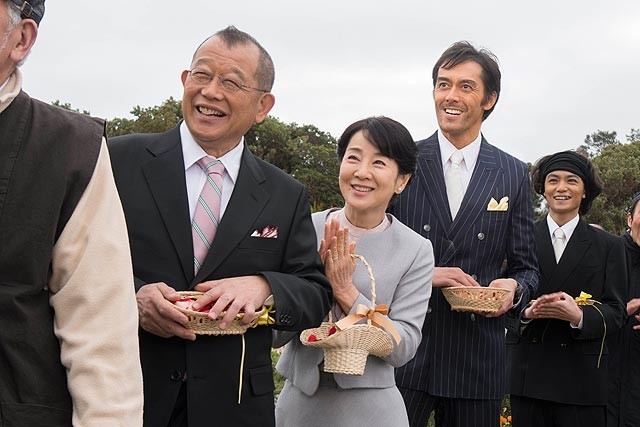
During my flight home from Hawaii I watched the film ふしぎな岬の物語 (Fushigi na misaki no monogatari) or Cape Nostalgia, which I have wanted to see since it came out at the end of last year in Japan and got rave reviews. It is based on a book by Akio Morisawa, and tells the story of a café situated along a small cape in Chiba that is run by an elderly woman named Etsuko Read More
Justin’s Japan: Nippon in New York — Ghibli Premiere, L’arc~en~Ciel, Steve Aoki, Rinko Kikuchi
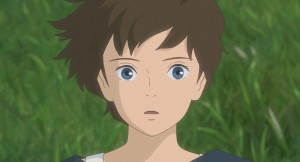
When Marnie Was There, the newest film from Studio Ghibli, premieres in North America Feb. 27 at DGA Theatre. (© 2014 GNDHDDTK)
By JQ magazine editor Justin Tedaldi (CIR Kobe-shi, 2001-02) for Examiner.com. Visit his Japanese culture page here for related stories.
Stay warm this winter with some hot local events, from an unmissable North American anime premiere, a documentary on one of Japan’s hottest acts, and concerts featuring some of the biggest names in electronic music, taiko, and indie rock.
This month’s highlights include:
Friday, Feb. 27, 8:30 p.m.
DGA Theatre, 110 West 57th Street
$16
North American premiere! The newest feature from Japan’s famed Studio Ghibli is a sweeping story of friendship, mystery, and discovery that delivers stirring emotions and breathtaking animation as only Ghibli can. When shy, artistic Anna moves to the seaside to live with her aunt and uncle, she stumbles upon an old mansion surrounded by marshes, and the mysterious young girl, Marnie, who lives there. The two girls instantly form a unique connection and friendship that blurs the lines between fantasy and reality. As the days go by, a nearly magnetic pull draws Anna back to the Marsh House again and again, and she begins to piece together the truth surrounding her strange new friend. Based on the novel by Joan G. Robinson, and directed by Hiromasa Yonebayashi (The Secret World of Arriety), When Marnie Was There has been described as “Ghibli Gothic,” with its moonlit seascapes, glowing orchestral score, and powerful dramatic portrayals that build to a stormy climax. In Japanese with English subtitles.
Sunday, March 1, 3:00 p.m.
Over the L’arc~en~Ciel: Documentary Films “World Tour 2012~”
Anthology Film Archives, 32 Second Avenue
$10
This new documentary follows a legendary rock band who never fear to take challenges on the international stage, when they have already reigned over the domestic music scene. L’Arc~en~Ciel, after celebrating their 20th anniversary, embarked on a massive world tour that no other Japanese rock band had ever done before. From March 3rd to May 31st, 2012, L’Arc~en~Ciel’s 14-city world tour hit Hong Kong, Bangkok, Shanghai, Taipei, New York, London, Paris, Singapore, Jakarta, Seoul, Yokohama, Osaka, Tokyo, and Honolulu with a total attendance of 450,000 people. The band became the first solo Japanese act ever to perform at Madison Square Garden. In Japanese with English subtitles.
Monday, March 9, 7:30 p.m. and 9:30 p.m.
Dizzy’s Club Coca-Cola, 10 Columbus Circle
$25, $15 students
Renowned Japanese pianist Chihiro Yamanaka is one of her native country’s most popular. Luckily for us, she recently moved to New York City. She’s especially well-known for leading trios, and with Jazz at Lincoln Center favorite Yasushi Nakamura on bass and rising star Kush Abadey on drums, this group stands up to those high expectations. On top of virtuosic, light-speed chops, Yamanaka has an irresistible bounce to her playing and writing.
For the complete story, click here.
Justin’s Japan: Nippon in New York — Kawaii Central, Japan Week, Mr. Big, the Last ‘Naruto’
By JQ magazine editor Justin Tedaldi (CIR Kobe-shi, 2001-02) for Examiner.com. Visit his Japanese culture page here for related stories.
Stay warm this winter with some hot local events, from an exhibition for the whole family that’s perfect for introducing kids to Tokyo life, a big-screen anime farewell to a certain ninja you won’t want to miss, and an annual showcase that brings the sights (and tastes) of Japan to vivid life.
This month’s highlights include:
Now through May 17
Children’s Museum of Manhattan, 212 West 83rd Street
$11 children/adults, $7 seniors
Experience Tokyo’s vibrant culture in a new interactive exhibit! Children will have fun learning about life in present day Japan in this playful, highly immersive environment that transports families to two distinct areas of Tokyo that exist side by side: one serene and exquisite, the other, too cute for words. Kawaii Central is a streetscape inspired by Tokyo’s bustling Harajuku district, bursting with color, trendy shops and cuter than cute styles. Kids sing karaoke, smile for the photo booth camera, serve up a seasonal Japanese meal, and design adorable mascots for their families. Plus, learn more about contemporary Japan through special programs for the public, free with admission.
Jan. 29-31, 7:30 p.m.
Miwa Yanagi Zero Hour: Tokyo Rose’s Last Tape
Japan Society, 333 East 47th Street
$35, $28 Japan Society members
Stranded in Japan during World War II, a young Japanese-American woman was forced to serve as a radio broadcaster for a propaganda program controlled by the Japanese Imperial Army, and was subsequently tried for treason. Seventy years later, this historic incident is brought to life through a visually stunning whodunit, conceived, written and directed by internationally renowned visual artist Miwa Yanagi. Brimming with iconic imagery from her rich body of photographic work, Zero Hour tells the multi-layered story of a woman caught between two nations during the war. This presentation marks Yanagi’s North American debut as a theater artist. Performed in English and Japanese with English subtitles.
Feb. 7-8
Music from Japan: East Asian Vibrancy and Highlights of MFJ Commissions III
Asia Society, 725 Park Avenue
$20-$40
Over two days, Music from Japan’s 40th anniversary will be commemorated with exciting cross-cultural collaborations between musicians from Japan and its neighboring countries, China and Korea. Three internationally acclaimed traditional instrumentalists from Japan, Korea, and China will perform contemporary and classical repertoire on their respective instruments. A series of solo works will be followed by a group improvisation and the world premiere of Unkai (Sea of Clouds), written by MFJ-commissioned composer Ned Rothenberg especially for the occasion. The following afternoon, to celebrate MFJ’s long history of commissioning Japanese and American composers to create new work, two new MFJ commissions will be presented alongside a retrospective of compositions from prior years.
For the complete story, click here.
WIT Life #279: 東京家族
WIT Life is a periodic series written by professional Writer/Interpreter/Translator Stacy Smith (Kumamoto-ken CIR, 2000-03). She starts her day by watching Fujisankei’s newscast in Japanese, and here she shares some of the interesting tidbits and trends along with her own observations.
I can’t believe I haven’t posted here in over a month, though I think I know part of the reason why. Last month TV Japan offered a free two-week viewing period of its programming for non-subscribers. During this time I got used to watching this 24-hour Japanese channel, particularly its wide array of news shows that are really useful for learning vocabulary for interpreting. The service is through NHK Cosmomedia America, and will be very familiar to those of you who followed NHK’s programming in Japan. There are multiple daily news shows, including internationally focused ones and one I really like called Today’s Close-Up (現代クロースアップ) which takes a deep dive into a particular subject. For $25 a month you can be immersed in the world of Japan, so I immediately became a subscriber when the trial period ended (TV Japan is offering a $50 rebate if you sign up before the end of the year and maintain your subscription for at least three months!). I’ve not only been studying via the news but also getting back into Read More
Rafael Villadiego (Nagasaki-ken 2010-2013) writes for Green Tea Grafitti and reviews Tokyo Tribe.

Rap battles with actual battle
In a dystopian, not-so-distant-future Tokyo that has fallen into urban decay, young thugs rule the streets and the disparate districts have been divided between the various gangs that hold sway over their respective neighbourhoods. There is an uneasy alliance between these tribes as long as each adheres to the unspoken truce of keeping out of each others’ allocated territory.
But none of the tribes are entirely satisfied with maintaining the status quo and are chomping at the bit to prove their superiority and expand their sphere of influence.
All this teetering tinder box needs is a spark to push it completely off the edge and set the entire thing on fire.
Enter Mera (Suzuki Ryohei), leader of the ‘Bukuro Wu-Ronz, who is seeking to finally settle an old score with the Musashino Saru’s, Kai (rapper Young Dais). Mix in the insane Yakuza boss Big Buppa (Takeuchi Riki) and the kung-fu kicking virginal daughter of an international crime lord, Sunmi (Seino Nana), and you have all the ingredients for one unforgettable night through the myriad maze of this doomed metropolis, where all the simmering tribal rivalries are finally set to boil over.
Who will win the war for the streets of Tokyo? Plug in the speakers, pump up the volume and strap in for one epic ride.
The inimitable Sono Sion is back with a hybrid hip-hop, musical, gangster battle epic that defies easy categorisation or description. Over-the-top to the point of parody, this film will either provide an entertainingly rollicking departure from standard cinema fare, or turn viewers off entirely. Replete with a mish-mash of genre cliches and tongue-in-cheek references to classic Hollywood and Japanese cinema. In short, it is exactly what the seemingly ludicrous blurb of the film promised. Yet some people still had the audacity to get-up and leave – obviously not realising just what they had signed up for.
Our guide to the evening’s festivities is MC SHOW (embodied by Sion Sono alum Sometani Shota) who sets the stage for this sprawling rap narrative in what is shapes up to be one heck of a ride through an alternate Tokyo where gangs rule the streets and anything goes. The only rule is that you don’t cross into another gang’s turf. But this turns out to be the night when rules are meant to be broken, which just might ignite an all-out war that will set the streets of Tokyo alight.
The storyline is paper-thin, but the narrative is carried forward on sheer energy, lyrical verve and musical drive. With references to old-school yakuza gangster flicks, Broadway musicals and underground “pinku” cinema, the film offers a veritable smorgasbord of z-grade schlock and kitschy action extravagance. Populated by a veritable who’s-who of old-school Japanese hip-hop and rap royalty, led by Young Dais, the majority of roles are filled by street-level, non-actors ranging from tattoo artists to stunt performers. Despite lacking requisite thespian credentials, they are instead fully versed in the world Sion is attempting to create, lending an air of authenticity to the work and lyrical legitimacy to the rhymes.
The lyrics themselves range from street-level swagger to the scintillatingly surreal, to the downright hilarious. Are these wannabe posers or veterans so far above the game they are willing to poke fun at their own expense? There are moments when one cannot be entirely certain. But it is clear that these indisputable artists are fully committed to the cause and believe unequivocally in the unfolding struggle.
There are some mind-boggling action sequences drenched in veritable buckets of blood all captured in sweeping single-take shots that fully immerse you in this sprawling epic. It certainly reaches a point where style and artifice well and truly rule over any form of substance. So if you are looking for a deeper statement on the human condition or an underlying message amidst all this madness, you may find yourself disappointed.
But if you are happy to check your brain at the door and fully immerse yourself in Sion Sono’s insane symphony, then plug yourself in and raise your fists high as you cheer on the love and peace of the Musashino Saru in their struggle to prevail against the all-out-mayhem declared by the warlike Waru.
At the close of the film, we eventually discover the idiosyncratically innocuous circumstance that set the entire war in motion, and you will either laugh or cry – or more than likely, both.
Watch this film if…
…you are hankering for rap infused, hip-hop action epic through the streets of Tokyo…
“Tokyo Tribe” (Tokyo Toraibu) was released August 30 2014 in Japan, starring Suzuki Ryohei, Young Dais, Seino Nana, Sato Ryuta, Kubozuka Yousuke, Takeuchi Riki, Sometani Shota.

